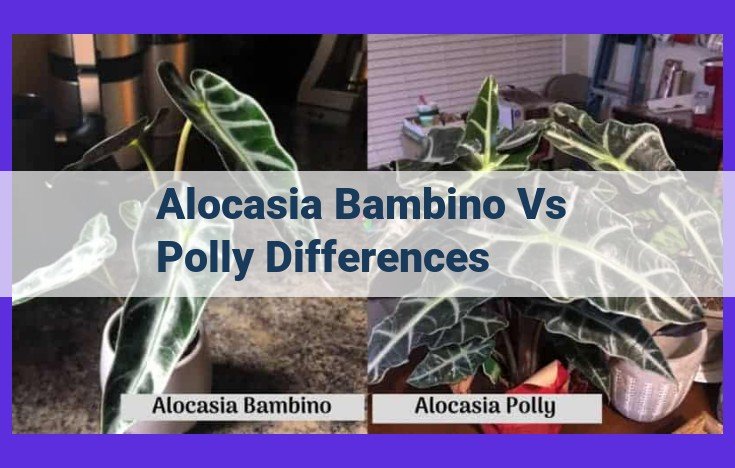Alocasia Bambino Vs. Polly: Unraveling The Visual And Care Differences
Alocasia bambino and polly are visually stunning plants with subtle differences. Bambino is smaller, featuring velvety dark green leaves with prominent veins. Polly, on the other hand, exhibits larger, glossy leaves with a silver-green hue. Both species have upright growth habits, but bambino tends to be more compact. In terms of care, polly prefers brighter indirect light, while bambino tolerates lower light. Both require moderate watering and humidity and should be kept away from pets due to their toxicity. Ultimately, bambino is ideal for smaller spaces or low-light areas, while polly makes a statement in larger rooms with ample light.
Alocasia Bambino vs. Polly: Unraveling the Enchanting Differences
In the lush realm of houseplants, the captivating Alocasia genus reigns supreme, boasting two alluring species that often leave plant enthusiasts captivated: the petite Alocasia Bambino and the statuesque Alocasia Polly. While sharing a common lineage, these enchanting plants possess distinct characteristics that set them apart in the horticultural world.
A Tale of Two Beauties
Both Alocasia Bambino and Polly hail from tropical rainforests, where they thrive under the dappled sunlight and high humidity of their native environments. Alocasia Bambino, true to its name, is a compact charmer, reaching a maximum height of just 12 inches. Its dense foliage forms a buxom mound, making it an ideal choice for smaller spaces or as a centerpiece on a desk or tabletop.
In contrast, Alocasia Polly commands a more regal presence, towering over its Bambino counterpart at a height of up to 3 feet. Its leaves, larger and more elongated, boast an impressive spread that can add an air of drama to any room. Whether you seek a petite accent or a statement piece, these two Alocasia species offer the perfect solution.
Alocasia Bambino vs. Polly: Understanding the Differences in Size and Growth Habit
When it comes to choosing the perfect Alocasia for your home, understanding the size and growth habit of each variety is crucial. While Alocasia Bambino and Polly share the same stunning foliage, they differ significantly in these aspects.
Plant Size
Alocasia Bambino is a compact plant that typically grows between 6 to 12 inches in height. Its smaller size makes it a great choice for smaller spaces like desks or windowsills. Alocasia Polly is a larger variety, reaching heights of 3 to 6 feet. It’s a dramatic focal point for larger rooms or offices.
Growth Rate
Both Alocasia Bambino and Polly are considered medium to fast growers. However, Alocasia Bambino tends to grow slightly slower than Polly. This slower growth rate makes it a more manageable option for those who prefer more controlled plant growth.
Shape
Alocasia Bambino has a rounded to heart-shaped growth habit, with leaves that curve gently downwards. Alocasia Polly has a more upright growth habit, with leaves that stand nearly vertical to the stem. This upright habit gives Polly a more slender and elegant appearance.
Leaf Morphology and Color
When it comes to aesthetics, Alocasia Bambino and Polly flaunt their radiant leaves with distinct characteristics.
Alocasia Bambino’s leaves are smaller, measuring around 4-8 inches in length, compared to Polly’s larger leaves that can reach up to 12 inches. Both species possess captivating arrowhead-shaped leaves, but Bambino’s are more compact, giving it a petite appearance.
The color patterns on these leaves are where they truly shine. Bambino boasts deep emerald green leaves with prominent veins, creating a stunning contrast. Its leaves curl slightly upwards at the tips, adding a touch of whimsy to its silhouette.
Polly, on the other hand, exhibits a darker green hue with a velvety texture. Its leaves are adorned with intricate silver veins, giving them an almost metallic sheen. These veins spread from the center, creating a stunning radial pattern that captivates the eye.
Stem Color and Growth Requirements:
The charming stems of Alocasia Bambino and Polly are vital elements that distinguish these tropical beauties. Bambino boasts enchanting emerald green stems that contrast beautifully with its lush foliage. Polly, on the other hand, captivates with its striking burgundy stems that add a touch of elegance to any room.
Light plays a crucial role in the health of both varieties. While they prefer bright, indirect light, too much direct sunlight can scorch their delicate leaves. Alocasias thrive in environments with humidity levels between 50-70%. Regular misting or placing them on a pebble tray filled with water can help maintain optimal moisture levels.
Water requirements for Alocasias are moderate. Allow the topsoil to dry out slightly between waterings. Overwatering can lead to root rot, so err on the side of caution. Fertilize your plants monthly during the growing season (spring and summer) with a balanced liquid fertilizer.
Temperature is another important factor for these tropical plants. They prefer temperatures between 65-85°F (18-29°C). Avoid exposing them to temperatures below 55°F (13°C) as this can cause damage.
Toxicity and Pet Safety
It’s crucial to be aware of the potential hazards posed by Alocasia Bambino and Polly to both humans and animals before bringing them into your home. Both species contain toxic compounds called calcium oxalates, which can cause discomfort and irritation if ingested.
Symptoms of exposure include:
- Intense burning and swelling in the mouth and throat
- Difficulty swallowing
- Nausea and vomiting
- Diarrhea
If you suspect your pet has ingested any part of either plant, seek veterinary assistance immediately. Keep both species out of reach of children and curious pets, and remember that early diagnosis and treatment are essential for minimizing the risks of toxicity.
